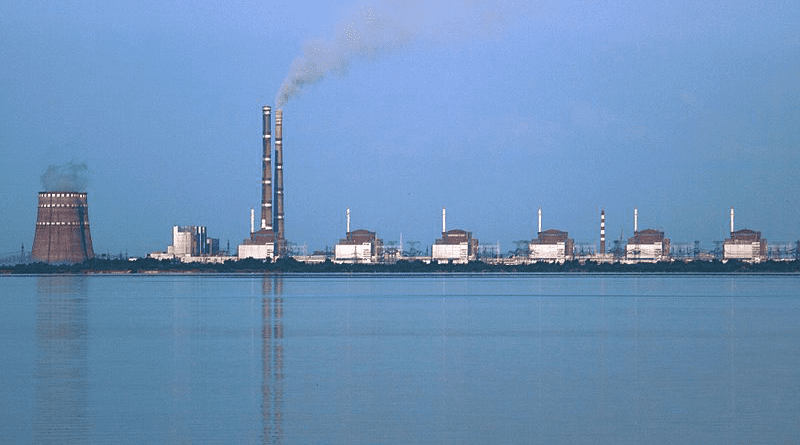Zaporizhzhya Nuclear Plant Declared Russian ‘Federal Property’ After Putin Signs Annexation Decrees
By RFE RL
(RFE/RL) — In one of his first moves to assert rule over areas of Ukraine that Russia has declared as its own, President Vladimir Putin on October 5 ordered the Russian state to seize complete control of the Zaporizhzhya nuclear power plant, a move immediately rejected by Kyiv.
Putin announced the move after signing decrees that Moscow claims absorb into Russia four regions that it only partially controls. Putin said Russia would stabilize the situation in the four regions — Donetsk, Luhansk, Kherson, and Zaporizhzhya — after signing the decree that designated the nuclear power plant as “federal property.”
“The Zaporizhzhya nuclear plant is now on the territory of the Russian Federation and, accordingly, should be operated under the supervision of our relevant agencies,” RIA news agency quoted Deputy Foreign Minister Sergei Vershinin as saying.
The Zaporizhzhya nuclear power plant, which has been occupied by Russian forces since March, is still run by Ukrainian engineers.
Rosenergoatom, Russia’s nuclear power operator, said it would conduct an assessment of damage to the plant’s infrastructure and would transfer the Ukrainian employees to a new Russian-owned organization.
“The new operating organization is designed to ensure the safe operation of the nuclear power plant and the professional activities of the existing plant personnel,” it said in a statement.
Ukraine’s state nuclear energy company Enerhoatom said Putin’s decree and other Russian documents regarding the Zaporizhzhya nuclear power plant were “worthless, absurd and inadequate.”
“The Zaporizhzhya [nuclear power plant] will continue to operate in Ukraine, in accordance with Ukrainian legislation, in the Ukrainian energy system, in Enerhoatom,” the regulator said.
Kyiv has long said that Moscow plans to switch the plant from Ukraine’s power grid to Russia’s. The power station is located on the Russia-controlled bank of a reservoir with Ukrainian forces on the opposite bank. Both sides and the International Atomic Energy Agency (IAEA) have warned that fighting near the plant increases the danger of a nuclear disaster.
IAEA chief Rafael Grossi on October 5 said he was headed to Kyiv by train and would visit Moscow later this week. Grossi said negotiations on a safe zone around the plant were more important than ever.
Putin’s signature on the decrees to illegally annex the four regions, which Moscow only partially controls, finalizes a seizure carried out in defiance of international law. The areas claimed by Russia account for about 18 percent of Ukraine’s territory.
Ukrainian forces continued to make advances into several of the four regions, raising doubts about Moscow’s capacity to assert control over those territories even as the Kremlin vowed to reoccupy them.
“The given territories will be taken back,” Kremlin spokesman Dmitry Peskov told reporters after Putin signed the decree incorporating them into Russia.
Asked if there was a contradiction between Putin’s gesture and the reality of the retreat of Russian forces on the ground, Peskov said, “There is no contradiction whatsoever. They will be with Russia forever and they will be returned” to Russian control.
Ukrainian President Volodymyr Zelenskiy said in his nightly address on October 4 that his forces have made “rapid and powerful” gains in southern Ukraine and recaptured “dozens” of villages from Russia this week.
The liberation of Luhansk, which is almost completely under Russian control, is well under way, the region’s Ukrainian governor, Serhiy Hayday, said in a post on Telegram on October 5.
The Ukrainian military liberated six settlements in Luhansk region Hayday said on Ukrainian TV. He did not specify the names of these settlements out of concern that Russian forces would then attack them.
“I will hold a pause until the official information of the General Staff. I can only say that these are six settlements,” said Hayday.
The purported advances in Luhansk, which could not be independently confirmed, came after maps revealed by Moscow on October 4 showed that Russian troops had left many areas in Kherson, including along the west bank of the Dnieper River.
In the northeastern Kharkiv region, the maps indicated that Russian forces had almost entirely abandoned the east bank of the Oskil River, where British intelligence saidUkraine has now “consolidated” a substantial area.
“Ukrainian formations have advanced up to 20 km beyond the (Oskil) river into Russia’s defensive zone towards the supply node of the town of Svatove,” Britain’s Ministry of Defense said in its daily intelligence bulletin.
“Russian leaders will highly likely be concerned that leading Ukrainian units are now approaching the borders of Luhansk Oblast, which Russia claimed to have formally annexed [on September 30],” British intelligence suggested.

